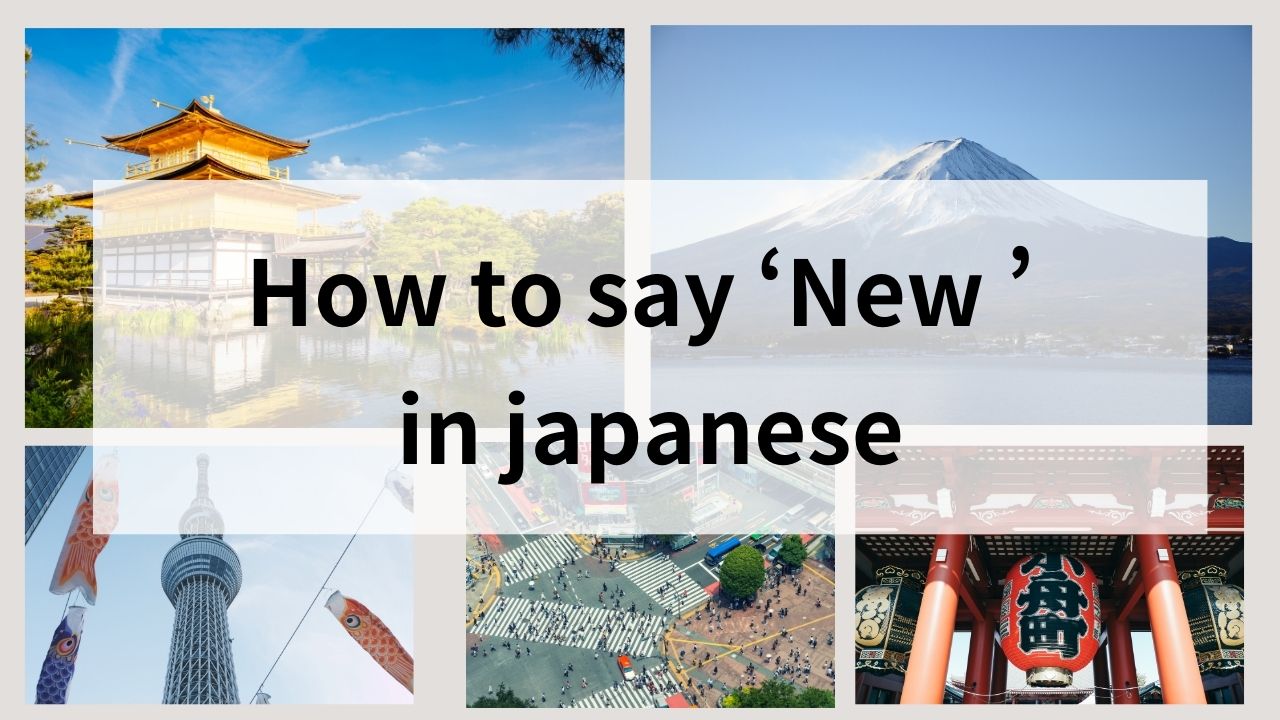Are you curious about how to say “new” in Japanese? The concept of “new” carries various meanings and implications in Japanese culture, influencing everything from language to social interactions. This guide will explore the Japanese word for “new,” its cultural significance, and practical applications.
How Do You Say “New” in Japanese?
The Japanese word for “new” is 新しい (atarashii). This term is widely recognized and used in both casual and formal contexts. The idea of “new” is often associated with freshness, innovation, and change in Japan.
The Japanese Word for New: Atarashii (新しい)
“Atarashii” is a term used to describe something that is new or fresh and appears in various phrases and contexts. For example:
- 新しい車 (Atarashii kuruma): “New car.”
- 新しい家 (Atarashii ie): “New house.”
- 新しい仕事 (Atarashii shigoto): “New job.”
Kanji for New: 新
The kanji for new, 新, is commonly used in literature, traditional contexts, and everyday language. This visually striking character reflects the themes of renewal and innovation. The primary reading for this kanji is あたらしい (Atarashii), but it also has alternative readings based on context.
Examples of words containing the kanji 新 include:
- 新年 (Shinnen): “New Year,” a significant time for renewal and celebration in Japanese culture.
- 新作 (Shinsaku): “New work,” often used to refer to new artistic or literary creations.
- 新鮮 (Shinsen): “Fresh,” usually referring to food or produce and its quality.
This kanji is commonly associated with things that represent freshness or new beginnings. Recognizing these patterns can help learners understand the nuanced use of 新 in Japanese.
Does “New” Work in Japanese?
The English word “new” is generally understood in Japan, especially among younger generations or those familiar with modern culture. However, its recognition might be less universal among older individuals or in more traditional contexts. A 5-point scale rates its comprehension as:
- Rating: 4 – Generally understood (60-80% of people)
Rating Details
Understanding the 5-Point Rating for English Words in Japan
The following ratings help explain how English words are typically understood in Japan. The scale is based on context, familiarity, and the target audience.
- 5 - Universally understood (80% or more):
Words that are widely adopted into everyday Japanese, such as "coffee" (コーヒー) or "computer" (コンピューター). These words are part of the standard vocabulary and are recognized by nearly everyone. - 4 - Generally understood (60-80%):
Words that are familiar to most people but might require context for full comprehension. Examples include terms commonly used in specific industries or by younger generations. - 3 - Understood in half of the cases (40-60%):
Words that depend heavily on pronunciation or context. For example, technical terms or less common foreign words that some people may not immediately recognize. - 2 - May not be understood (20-40%):
Words that are unfamiliar to most Japanese speakers unless they have significant exposure to English or specific cultural contexts. These words are often better replaced with their Japanese equivalents. - 1 - Rarely understood (20% or less):
Highly specialized or obscure terms that are unlikely to be recognized by the general public. Clear communication requires the use of Japanese vocabulary or additional explanation.
This rating system provides a practical guide for determining when and how to use English words effectively in Japan. Understanding the audience and context is key to ensuring clear communication.
If clarity is crucial, using the Japanese term 新しい (Atarashii) is recommended. While “new” may be understood in certain contexts, “atarashii” ensures effective communication.
The Cultural Significance of New in Japan
The concept of “new” has significant cultural importance in Japan, often linked to innovation, modernity, and change. This is reflected in various aspects of society, from technology to fashion.
Newness as a Symbol of Modernity
In contemporary Japan, the embrace of the “new” is evident in its cutting-edge technology and design. The country is known for its advancements and modern aesthetics, which emphasize innovation and creativity.
New in Japanese Folklore and Tradition
Historically, the new year celebrations in Japan are steeped in tradition, emphasizing renewal and fresh starts. Rituals and practices during this time highlight the cultural value placed on new beginnings.
Additionally, the concept of newness is reflected in modern Japanese pop culture, including anime and fashion, where new trends and ideas are constantly explored and celebrated.
- Anime Series: Many anime series introduce new characters or story arcs each season, symbolizing change and evolution.
- Fashion: Japanese street fashion is vibrant and ever-changing, with new styles emerging regularly, showcasing creativity and self-expression.
- Technology: Japanese companies are at the forefront of innovation, frequently releasing new products that shape global trends.
- Art: Contemporary artists often focus on new concepts and techniques, pushing the boundaries of traditional art forms.
These examples reinforce how the idea of “new” continues to play a vital role in Japanese culture, bridging traditional values with modern advancements.
Differences Between New in Japan and Overseas
Yes, there can be subtle differences in how “new” is perceived in Japan versus Western cultures. In Japan, “atarashii” often refers to a fresh start or innovation, emphasizing quality and refinement. Meanwhile, in Western contexts, “new” may encompass a broader range of meanings, focusing more on novelty and consumer trends. Understanding these cultural nuances can help avoid confusion, especially when discussing concepts of change or innovation.
Practical Applications of “New” in Japanese
Learning how “new” is used in Japanese can help you navigate conversations, understand idioms, and recognize its presence in Japanese culture.
Talking About New in Daily Conversation
Here are some examples of how “atarashii” is used in everyday conversation:
- 新しい服が欲しいです (Atarashii fuku ga hoshii desu): “I want new clothes.”
- 新しい友達ができました (Atarashii tomodachi ga dekimashita): “I made a new friend.”
New-Related Idioms or Expressions
While there are relatively few specific idioms involving “atarashii,” the concept of newness is often associated with change and innovation. Here are some idioms, phrases, and expressions that incorporate or symbolize new:
- 新しい風 (Atarashii kaze): Literally “new wind,” this phrase symbolizes new ideas or fresh perspectives.
- 新生 (Shinsei): Referring to “new life,” often used in contexts of renewal or rebirth.
- 新規開店 (Shinki kaiten): “Newly opened store,” commonly used in business to indicate a new establishment.
- 新しい挑戦 (Atarashii chousen): “New challenge,” often used to describe taking on new endeavors.
- 新参者 (Shinzanmono): “Newcomer,” used to describe someone new to a group or community.
These idioms and expressions reflect the appreciation for newness in Japan, often tied to themes of innovation, change, and fresh perspectives. By learning these phrases, you can gain a deeper understanding of how “new” is interwoven with Japanese language and values.
New in Japanese Cuisine or Products
Newness is also prominently featured in Japanese cuisine and products, showcasing innovation and trends. Here are some notable examples:
- Seasonal Dishes: Japanese cuisine often emphasizes fresh and seasonal ingredients, with new dishes emerging to reflect the changing seasons.
- New Flavors: Japanese snacks and beverages frequently introduce new and unique flavors, catering to evolving consumer preferences.
- Innovative Sweets: Confectioneries often experiment with new ingredients and presentation styles, showcasing creative culinary approaches.
These examples highlight how newness is not only visually appealing but also culturally significant in Japanese cuisine, adding richness and depth to both traditional and modern dishes.
FAQs
Here are some frequently asked questions about “new” in Japanese culture and language.
Is New a Popular Concept in Japan?
Yes, the concept of newness is highly valued in Japan, often associated with innovation and modernity. It is frequently celebrated in various fields, including technology, fashion, and art.
How Do You Write “New” in Japanese?
The word “new” can be written in three different scripts in Japanese: hiragana, katakana, and kanji. Each script serves different purposes depending on the context and formality. Here’s a breakdown:
- Hiragana (あたらしい, Atarashii):
Hiragana is the most commonly used script for “new” in casual writing or when teaching children. It is simple and easy to read, making it ideal for everyday use. - Katakana (アタラシイ, Atarashii):
Katakana is rarely used for “new,” but it may appear in stylistic contexts, such as advertisements, product names, or when emphasizing the word in text. - Kanji (新, Atarashii):
Kanji is the most formal and traditional way to write “new.” It is often used in literature, official documents, and cultural contexts. The kanji itself conveys a sense of innovation and freshness.
Choosing which script to use depends on the tone, audience, and purpose of your communication. Understanding these variations can enhance both your written and spoken Japanese skills.
Conclusion
“New,” or “atarashii” in Japanese, is more than just a word—it symbolizes innovation, change, and cultural significance. By understanding its role in Japanese language and traditions, you can deepen your appreciation for this concept and its importance in Japanese society.








